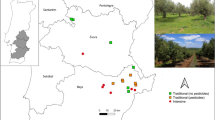Abstract
In olive orchards, which are very common in the Mediterranean region, cover crops are becoming increasingly used to counter problems of erosion. Although such plant covers can provide food and shelter for beneficial insects, mites, and spiders, they may also attract pests. In order to determine their relationships with the main pests in olive orchards, an analysis was made of adult population levels and damage caused in five olive-cultivation zones, in olive orchards with cereal-crop covers and in olive orchards with conventional tillage. The effects of the cereal cover crops on insect pest populations were different and in some cases in opposite direction. Thus cereal cover crops had no impact on the different studied pests, including all those that spend part of their development cycle in the soil, such as Bactrocera oleae, Prays oleae, or Otiorrhynchus cribicollis. However, under certain conditions some pests did show an increase in abundance. Diverse trophic relationships should be investigated in this agroecosystem in future studies in order to develop appropriate crop-management policies.
Similar content being viewed by others
References
Aldebis HK, Avila A, Mata M, Vargas-Osuna E (2004) Evaluación de los daños causados por la polilla del olivo, Prays oleae Bern. en distintas variedades y condiciones de cultivo. Bol Sanid Veg Plagas 30:649–656
Altieri MA (1999) The ecological role of biodiversity in agroecosystems. Agric Ecosys Environ 74:19–31
Andersen A (2003) Long-term experiments with reduced tillage in spring cereals. II. Effects on pests and beneficial insects. Crop Protect 22:147–152
Arambourg Y (1986) Traite d’entomologie oleicole. Consejo Oleícola Internacional, Madrid
Boccaccio L, Guidotti D, Petacchi R (2008) Landscape effects on the community of Bactrocera oleae parasitoids. In: First meeting of TEAM, Mallorca, p. 49
Cardenas M (2008) Análisis de la actividad ecológica de las arañas en el agroecosistema del olivar. PhD thesis, University of Granada, Spain
Civantos M (1999) Control de plagas y enfermedades del olivar. Consejo Oleícola Internacional, Madrid
Connell JH, Vossen PM (2007) Organic olive orchard nutrition. In: Vossen PM (ed) Organic olive production manual. University of California
González B, Rodríguez E, Fernández F, Civantos M, Campos M (2004) Influencia del manejo del suelo en las poblaciones de artrópodos en el cultivo del olivo. In: III Jornadas Técnicas Aceite Oliva, pp. 93–104
Guidotti D, Ragaglini G, Petacchi R (2005) Analysis of spatio-temporal Bactrocera oleae (Diptera, Tephritidae) infestation distributions obtained from a large-scale monitoring network and its importance to IPM. IOBC/wprs Bull 28(9):13–18
Lombardo N, Ianotta N (2002) Evolución de las técnicas de cultivo en el olivar meridional. Olivae 93:43–49
Norris RF, Bogan M (2000) Interactions between weeds, arthropods pest, and their natural enemies in management ecosystems. Weed Sci 48:94–158
Purtauf T, Roschewitz I, Dauber J, Thies C, Tscharntke T, Wolters V (2005) Landscape contex of organic and conventional farms: influences on carabid beetle diversity. Agric Ecosys Environ 108:165–174
Redolfi I, Tinaut A, Pascual F, Campos M (1999) Qualitative aspects of myrmecocenosis (Hym., Formicidae) in olive orchards with different agricultural management in Spain. J Appl Entomol 123:621–627
Ruano F, Lozano C, García P, Peña A, Tinaut A, Pascual F, Campos M (2004) Use of arthropods for the evaluation of the olive-orchard management regimes. Agric Forest Entomol 6:111–120
Sanchez J (2004) Influencia del manejo del olivar en el desarrollo de cubierta vegetal y en la presencia de la entomofuna útil para el desarrollo de Bactrocera oleae (Gmel.). Tesis Doctoral, Univ. Córdoba, Spain
Stinner BR, House GF (1990) Arthropods and other invertebrates in conservation-tillage agriculture. Ann Rev Entomol 35:199–318
Torres L (2007) Manual de Protecçao Integrada do Olival. J Acevedo, Portugal
Tzanakakis M (2006) Insects and mites feeding on olive. Distribution, importance, habits, seasonal development and dormancy. Brill, Leiden
Warlop F (2001) Oléiculture biologique: des perspective de solution á la mouche? Le nouvel Olivier 24:20–21
Acknowledgments
We thank M. Civantos and F. Fernández for their assistance. D. Nesbitt and Michael O’shea reviewed the English version of manuscript. This work was supported by research project CAO99-004 funded by FEGA-FEOGA and the Junta de Andalucía (AGR 109).
Author information
Authors and Affiliations
Corresponding author
Additional information
Communicated by M. Zalucki.
Rights and permissions
About this article
Cite this article
Rodríguez, E., González, B. & Campos, M. Effects of cereal cover crops on the main insect pests in Spanish olive orchards. J Pest Sci 82, 179–185 (2009). https://doi.org/10.1007/s10340-008-0237-6
Received:
Revised:
Accepted:
Published:
Issue Date:
DOI: https://doi.org/10.1007/s10340-008-0237-6




